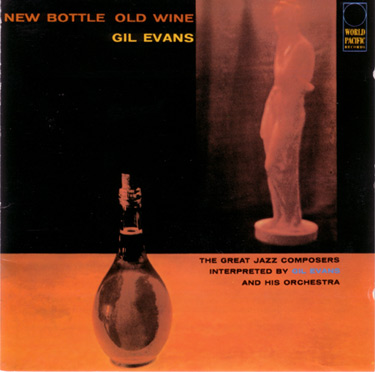Gil Evans - New Bottle Old Wine

"Miles Ahead" was recorded during the spring of 1957. It was the album that brought much critical acclaim to both Miles and Gil. In February 1958 Davis cut the masterpiece "Milestones" with Cannonball Adderley and he probably linked between him and Evans.
"New Bottle Old Wine" is a very fine and hard to find album that was made in the spring of 1958, just a few months before Gil's and Miles' ultimate masterwork "Porgy and Bess". One of the reasons for this album being so special are the warm solos by Cannonball. So different in approach than his boss at the time, Davis. I think it's one of his most inspired works. He catches the listener's ear from the start, playing a few bars just by himself, calling like a preacher with his blues wailings.
Evans uses some of his wonderful "trademark tricks". Teaming Julius Watkins' French horn with the trombones to create mellow chords and sometimes pairing it with the clarinet. It's amazing that he makes these chords sound totally Evansian just with the addition of the tuba and the French horn. He also likes to create trembling and disturbing sounds with the combination of muted horn, flute and one note long tremolo on guitar.
But it's not the arrangements, nor the wonderful work done by the star soloist Cannonball Adderley and other great musicians like Art Blakey and Johnny Coles and it's neither the tight and exact ensemble work. It's Evans the composer that really holds the interest for almost forty minutes. Strange statement indeed! The disc contains great jazz classics beginning from the New Orleans tradition ("St. Louis Blues" and "King Porter Stomp") to bebop ("Manteca" and "Bird Feathers") and none of them by Gil. Nevertheless he creates new music inside the old songs, something like an "inside composition".
This is obvious in his reworking of "Round Midnight" and "Manteca" which are sewed and connected together like a small suite. When "Manteca" starts only the bass plays the original rhythmic motive, which is central to Dizzy's original version. The melody is built from Dizzy's bridge. It is presented twice slower than the beat and creates a sad and melancholic effect. When the band finally launches into the leading dominant chord it sounds totally different from Dizzy's happy and energetic source. It's a bit dry, sad and has that special Spanish quality that appeared a lot afterwards in Gil's works.
Evans wrote a true tribute to his mental jazz parents, based on their creations but fresh and surprising.